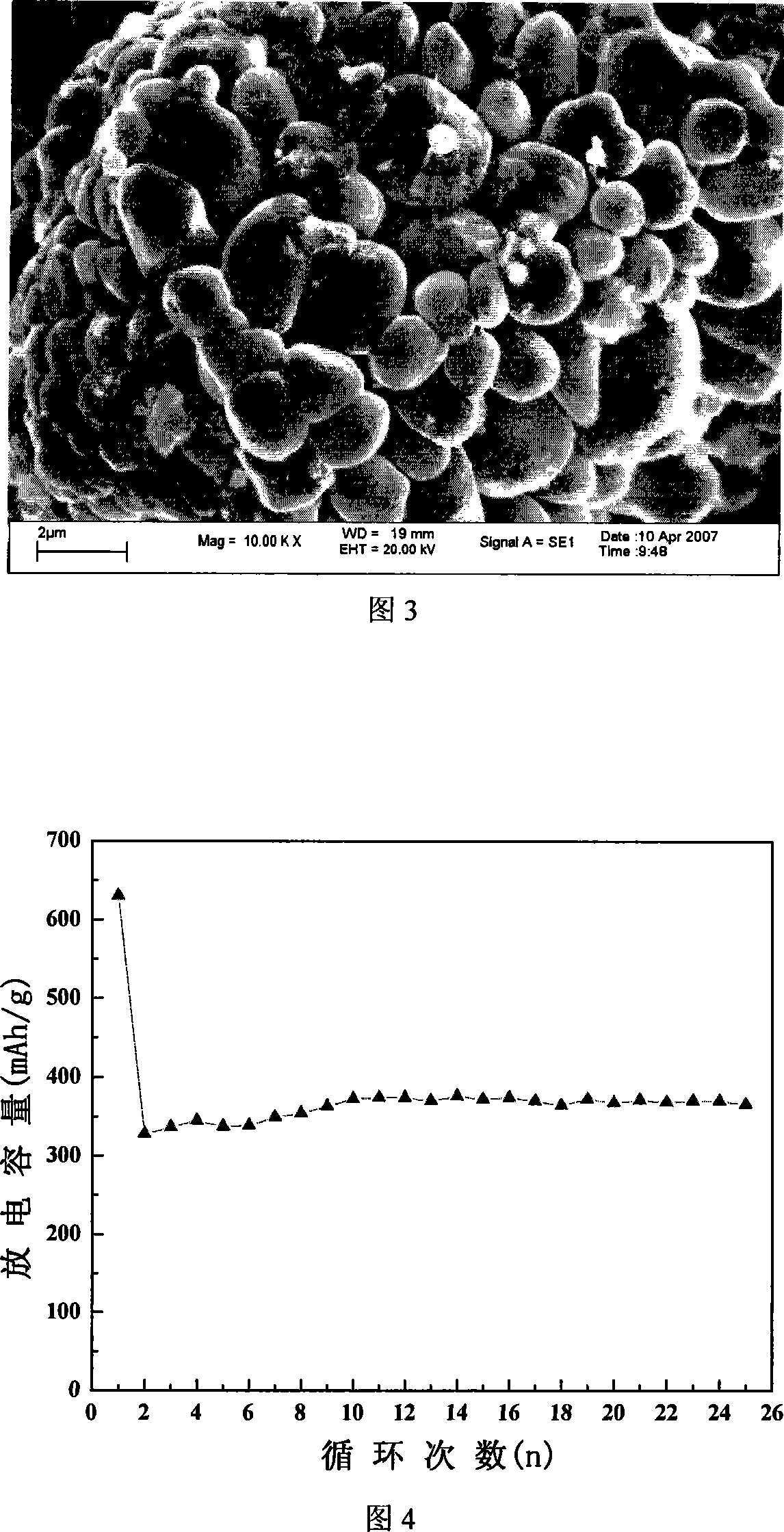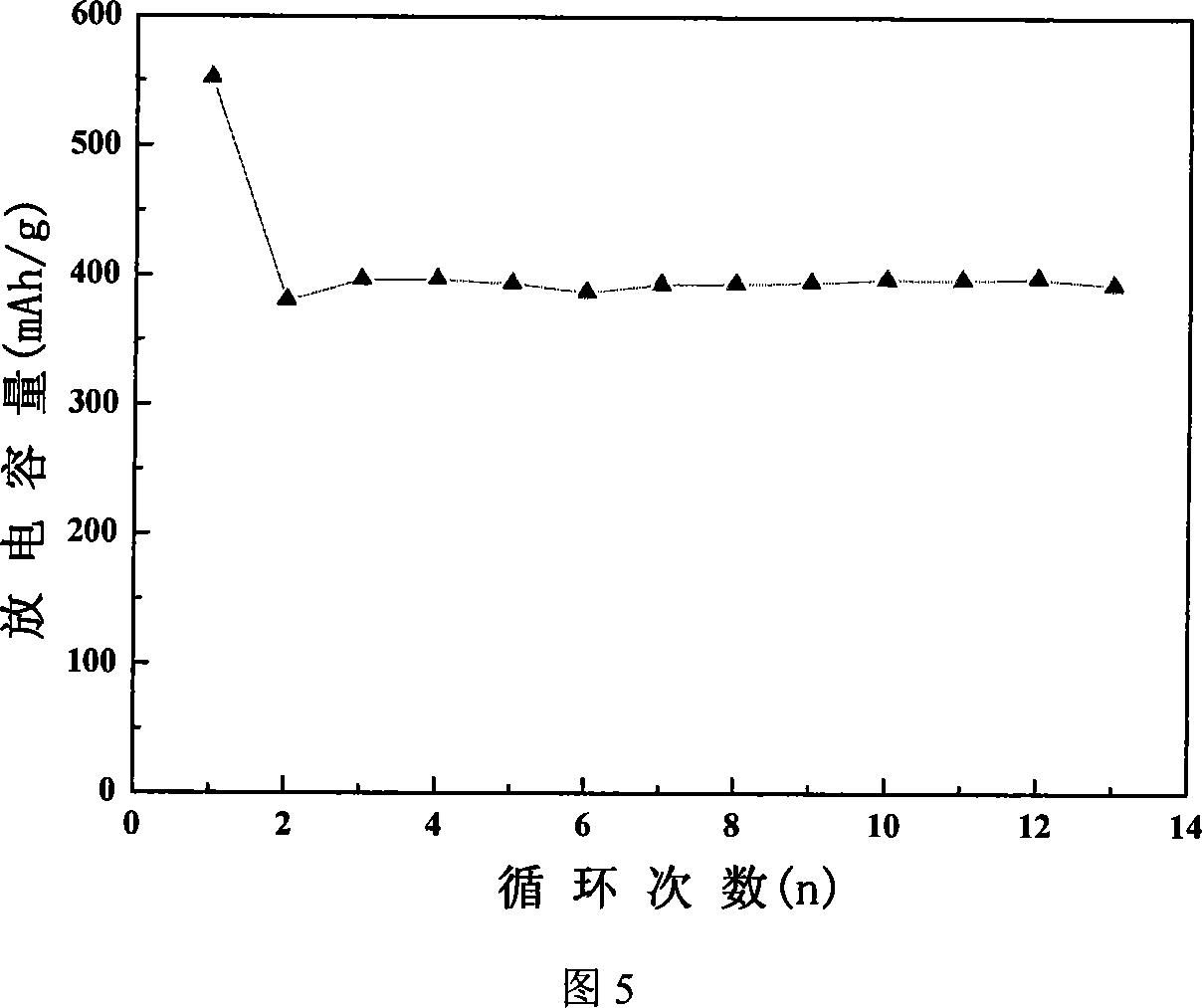A making method for tin, cobalt and carbon compound cathode materials of lithium ion battery
A technology of lithium-ion batteries and carbon composite materials, which is applied in the field of preparation of Sn-Co-C composite materials, can solve the problems of cycle stability to be improved, high-energy mechanical ball wear time, high process cost, etc., to improve cycle stability, The effect of low cost and simple preparation process
- Summary
- Abstract
- Description
- Claims
- Application Information
AI Technical Summary
Problems solved by technology
Method used
Image
Examples
Embodiment 1
[0023] with SnO 2 (purity 99.9%), CoCO 3 (purity 99.9%) and graphite carbon as the initial raw material, the molar ratio is 3: 1: 17 for batching, after the mixture is ground evenly, it is placed in a flowing argon atmosphere and raised to 950 °C with a heating rate of 3 °C / min. ℃, cut off the protective gas after 2 hours of heat preservation, and then cool to room temperature with the furnace after another 2 hours of heat preservation. The XRD phase analysis results of the obtained sample show that the synthesized product is mainly CoSn 2 , Sn and C phases.
[0024]Mix the synthesized material, the conductive agent acetylene black and the binder PVDF at a mass percentage of 80:10:10 to make a slurry, evenly coat it on the copper foil, dry it to make a circular pole piece, and assemble it with metal lithium A simulated battery was used to conduct constant current charge and discharge experiments. The charge and discharge current density was 100mA / g, and the charge and disch...
Embodiment 2
[0026] with SnO 2 (purity 99.9%), Co 3 o 4 (purity 99.9%) and activated carbon (purity > 99%) are the initial raw materials, and the molar ratio is 6:1:19. The heating rate was increased to 1000°C, and after 2 hours of heat preservation, the protective gas was cut off, and then cooled to room temperature. The XRD phase analysis results of the obtained sample show that the synthesized product is mainly CoSn 2 and phase C.
[0027] Mix the synthesized material, the conductive agent acetylene black and the binder PVDF at a mass percentage of 80:10:10 to make a slurry, evenly coat it on the copper foil, dry it to make a circular pole piece, and assemble it with metal lithium A simulated battery was used to conduct constant current charge and discharge experiments. The charge and discharge current density was 100mA / g, and the charge and discharge voltage was controlled between 0.01 and 1.5V. The prepared Sn-Co-C composite anode material has a lithium intercalation capacity of ...
Embodiment 3
[0029] with SnO 2 (purity 99.9%), CoO (purity 99.9%) and activated carbon (purity > 99%) are the initial raw materials, and the ingredients are mixed in a molar ratio of 3:1:9. After the mixture is ground evenly, it is placed in a flowing argon atmosphere The temperature was raised to 900°C at a rate of 5°C / min, and the protective gas was cut off after 2 hours of heat preservation, and then cooled to room temperature. The XRD phase analysis results of the obtained sample show that the synthesized product is mainly CoSn 3 , Sn and C phases.
[0030] Mix the synthesized material, the conductive agent acetylene black and the binder PVDF at a mass percentage of 80:10:10 to make a slurry, evenly coat it on the copper foil, dry it to make a circular pole piece, and assemble it with metal lithium A simulated battery was used to conduct constant current charge and discharge experiments. The charge and discharge current density was 100mA / g, and the charge and discharge voltage was co...
PUM
 Login to View More
Login to View More Abstract
Description
Claims
Application Information
 Login to View More
Login to View More - R&D
- Intellectual Property
- Life Sciences
- Materials
- Tech Scout
- Unparalleled Data Quality
- Higher Quality Content
- 60% Fewer Hallucinations
Browse by: Latest US Patents, China's latest patents, Technical Efficacy Thesaurus, Application Domain, Technology Topic, Popular Technical Reports.
© 2025 PatSnap. All rights reserved.Legal|Privacy policy|Modern Slavery Act Transparency Statement|Sitemap|About US| Contact US: help@patsnap.com



